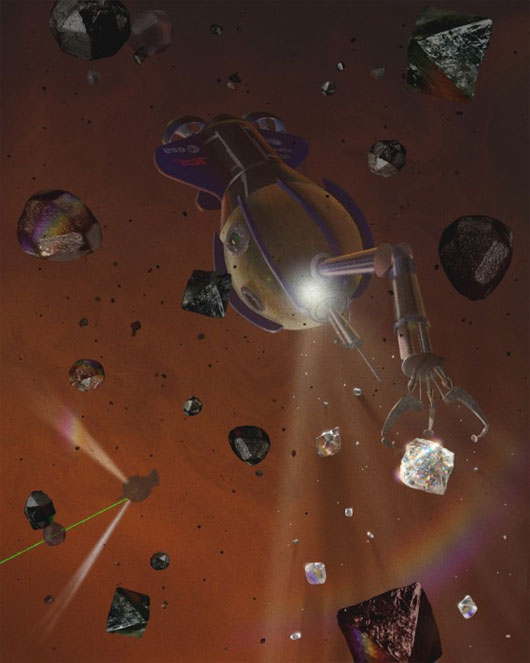Discovering diamond rain on Jupiter and Saturn
US scientists have just published their work on Jupiter and Saturn. It is worth noting that the two planets often have diamonds in the sky.
Two planetary scientists, Mona Delitsky of the Califoria Special Engineering Agency (CSE) in Pasadena, California, USA and Kevin Baines of the University of Wisconsin - Madison (USA) conducted research and said, Jupiter and Saturn may contain a lot of diamonds.
Standard models of planetary structures suggest that inside Saturn has a structure similar to that of Jupiter, with a hard rock core surrounded by hydrogen and helium with a small amount of volatile compounds in the atmosphere. .

People are about to bring ships to space to exploit diamonds?(Photo: Alien Seas)
According to scientists, diamonds can float in liquid streams of hydrogen and helium inside the atmosphere of Saturn and Jupiter. Furthermore, at lower depths, under extremely high pressure and temperature this precious stone is melted, meaning there will be diamond rains.
Baines and Delitsky scientists said: "Recent data have confirmed that at a certain depth, diamonds can float inside Saturn. Some places, gems grow too wide, so called "Diamond Mountain" ".
Diamonds can form when carbon (in graphite or soot caused by strong storms in Saturn's upper atmosphere) falls into the deep atmosphere of the planet. Here, it is pressed into diamonds. Later, the gems fall into the lower atmosphere, near the core of the planet and turn into liquid.
Scientists say solid diamonds can exist in relatively cold cores of Neptune and Uranus, but Jupiter and Saturn are thought to be too hot to form solid diamonds.
In the book Alien Seas, Baines and Delitsky wrote in detail about the exploiting ships that will be sent to Saturn in the future to collect diamonds and bring them back to Earth.
Although the process of creating diamonds is still a mystery, scientists think that on Earth, diamonds form naturally when carbon lies at a depth of 160km below the surface of the Earth. After that, the diamond needs to be heated to about 1093 degrees Celsius and under pressure of more than 4 billion Pascal. It also needs to quickly move to the surface of the Earth - usually following volcanic lava flows.
This study was presented at the 45th annual meeting of the American Astronomical Society on Planetary Science in Denver.
According to astronomers from the University of Arizona (USA), planet 55 Cancri e may also contain giant diamond mines. This planet is 40 light years from our Solar System. Astronomers say 55 Cancri e is richer in carbon than Earth is the ideal environment for diamond formation.
- Video: The rain of diamonds on Saturn is amazing
- 1000 tons of diamonds poured down on Saturn and Jupiter every year
- Jupiter and Saturn will shine beautifully in the sky from today
- Overview of Saturn
- Super typhoon on Jupiter is narrowing
- Saturn overtakes Jupiter with the number of orbiting satellites
- Admire the golden diamond 'terrible' rarely seen
- Titan Saturn Moon: 1,000 years a rain
- Simulate diamond rain on Neptune and Thien Vuong
- 10 best photos of interplanetary cruise ship
- The world's largest rough diamond has a master
- Cassini spacecraft said the latest information
 Van Allen's belt and evidence that the Apollo 11 mission to the Moon was myth
Van Allen's belt and evidence that the Apollo 11 mission to the Moon was myth The levels of civilization in the universe (Kardashev scale)
The levels of civilization in the universe (Kardashev scale) Today Mars, the sun and the Earth are aligned
Today Mars, the sun and the Earth are aligned The Amazon owner announced a secret plan to build a space base for thousands of people
The Amazon owner announced a secret plan to build a space base for thousands of people